Shreya Khisa
Joint Power Control and Antenna Positioning for Uplink RSMA in Pinching Antenna Systems
Dec 23, 2025Abstract:This paper investigates a rate-splitting multiple access (RSMA) for uplink pinching antenna system (PASS). Our objective is to maximize the uplink sum rate by jointly optimizing a continuous antenna positioning and user's transmission power. The formulated problem is highly non-convex and difficult to solve directly; to address this challenge, we propose an alternating optimization (AO) framework which decomposes the original problem into two tractable sub-problems, namely (i) power allocation optimization sub-problem and (ii) antenna position optimization sub-problem. Both sub-problems are solved using successive convex approximation (SCA)-based algorithm and solved alternatively until convergence. The RSMA access for PASS is compared with conventional non-orthogonal multiple access (NOMA) and space-division multiple access (SDMA) techniques. The performance of discrete antenna activation with PASS strategy is also examined. Simulation results demonstrate that our proposed framework significantly enhances the achievable sum rate compared to other multiple access methods.
Meta-Learning-Driven Resource Optimization in Full-Duplex ISAC with Movable Antennas
Oct 01, 2025

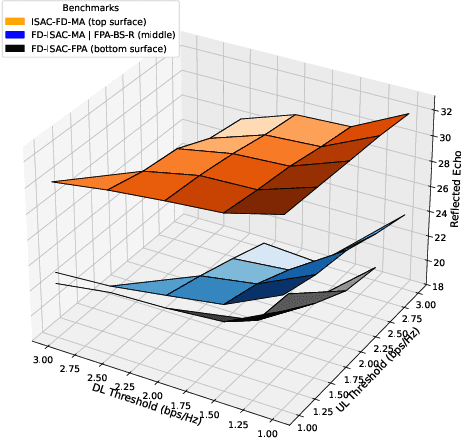
Abstract:This paper investigates a full-duplex (FD) scenario where a base station (BS) equipped with movable antennas (MAs) simultaneously provides communication services to a set of downlink (DL) and uplink (UL) users while also enabling sensing functionalities for target detection, thereby supporting integrated sensing and communication (ISAC) technology. Additionally, a receiving BS, also equipped with MAs (denoted as BS R), is responsible for capturing the reflected echo. To optimize this setup, we formulate an optimization problem aimed at maximizing the signal-to-noise and interference ratio (SINR) of the captured echo. This is achieved by jointly optimizing the transmit beamforming vectors at the FD BS, the receiving beamforming vectors at both the FD BS and BS R, the UL users' transmit power, and the MAs' positions at both BSs, all while satisfying the quality-of-service (QoS) requirements for both sensing and communication. Given the non-convex nature of the problem and the high coupling between the variables, we employ a gradient-based meta-learning (GML) approach tailored for large-scale optimization. Numerical results demonstrate the effectiveness of the proposed meta-learning approach, achieving results within 99% of the optimal solution. Furthermore, the MA-based scheme outperforms several benchmark approaches, highlighting its advantages in practical ISAC applications.
Meta-Learning Driven Movable-Antenna-assisted Full-Duplex RSMA for Multi-User Communication: Performance and Optimization
Apr 04, 2025



Abstract:Full-duplex (FD) radios at base station (BS) have gained significant interest because of their ability to simultaneously transmit and receive signals on the same frequency band. However, FD communication is hindered by self-interference (SI) and intra-cell interference caused by simultaneous uplink (UL) transmissions affecting downlink (DL) reception. These interferences significantly limit the ability to fully exploit FD's potential. Recently, movable antenna (MA) technology has emerged as a groundbreaking innovation, offering an effective way to mitigate interference by adjusting the position of each MA within the transmitter or receiver region. This dynamic repositioning allows MAs to move away from high-interference zones to areas with minimal interference, thereby enhancing multiplexing gain and improving spectral efficiency (SE). In light of this, in this paper, we investigate an FD communication system by integrating it with MAs to evaluate and investigate its effectiveness in handling SI and intra-cell interference. Moreover, we utilize rate-splitting multiple access (RSMA) as our multiple access technique in both UL and DL transmission. To achieve the full potential of the system, we evaluated three different scenarios with FD-BS-RSMA with MAs where our goal is to maximize the total sum rate of the system by jointly optimizing the transmitting and receiving beamforming vectors, UL user equipment (UE) transmission power, MA positions, and common stream split ratio of RSMA while satisfying the minimum data rate requirements of all UEs, common stream constraint, power budget requirements of BS and UL UEs, and inter-MA distance. The formulated optimization problem is highly non-convex in nature, and hence, we propose a gradient-based meta-learning (GML) approach which can handle the non-convexity in a discrete manner by optimizing each variable in a different neural network.
Enhancing CoMP-RSMA Performance with Movable Antennas: A Meta-Learning Optimization Framework
Feb 24, 2025Abstract:This study investigates a downlink rate-splitting multiple access (RSMA) scenario in which multiple base stations (BSs), employing a coordinated multi-point (CoMP) transmission scheme, serve users equipped with movable antenna (MA) technology. Unlike traditional fixed-position antennas (FPAs), which are subject to random variations in wireless channels, MAs can be strategically repositioned to locations with more favorable channel conditions, thereby achieving enhanced spatial diversity gains.To leverage these advantages and maximize the achievable sum rate, we formulate an optimization problem that jointly determines the optimal transmit beamforming vectors at the BSs, the common stream allocation for different users, and the optimal positioning of the MAs, all while ensuring compliance with quality of service (QoS) constraints. However, the formulated problem is non-convex and computationally challenging due to the strong interdependence among the optimization variables. Traditional methods for solving large-scale optimization problems typically incur prohibitively high computational complexity. To address the above challenge, we propose a gradient-based meta-learning (GML) algorithm that operates without pre-training and is well-suited for handling large-scale optimization tasks. Numerical results demonstrate the effectiveness and accuracy of the proposed approach, achieving near-optimal performance (exceeding 97% compared to the optimal solution). Moreover, the MA-enabled CoMP-RSMA model significantly outperforms conventional benchmark schemes, yielding performance gains of up to 190% over the spatial division multiple access (SDMA) scheme and 80% over the RSMA FPA-based model. Finally, the proposed approach is shown to mitigate the sum-rate limitations imposed by interference in SDMA, achieving superior performance with fewer BSs.
Gradient-Based Meta Learning for Uplink RSMA with Beyond Diagonal RIS
Oct 23, 2024



Abstract:Beyond diagonal reconfigurable intelligent surface (BD-RIS) has emerged as an innovative and generalized RIS framework that provides greater flexibility in wave manipulation and enhanced coverage. In comparison to conventional RIS, optimization of BD-RIS is more challenging due to the large number of optimization variables associated with it. Typically, optimization of large-scale optimization problems utilizing traditional optimization methods results in high complexity. To tackle this issue, we propose a gradient-based meta learning algorithm which works without pre-training and is able to solve large-scale optimization problems. With the objective to maximize the sum rate of the system, to the best of our knowledge, this is the first work considering joint optimization of receiving beamforming vectors at the base station (BS), scattering matrix of BD-RIS and transmission power of users equipment (UEs) in uplink rate-splitting multiple access (RSMA) communication. Numerical results demonstrate that our proposed scheme can outperform the conventional RIS RSMA framework by 22.5$\%$.
Optimizing Multi-User Uplink Cooperative Rate-Splitting Multiple Access: Efficient User Pairing and Resource Allocation
Sep 03, 2024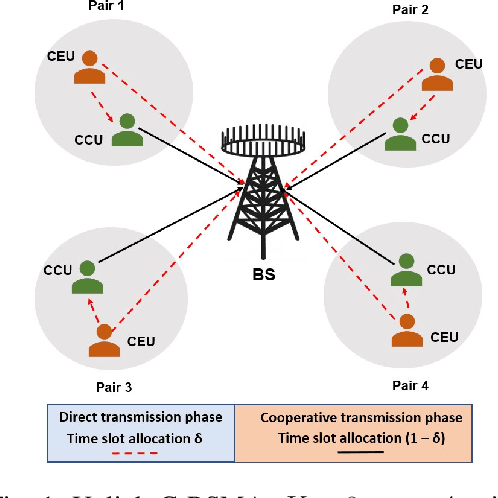
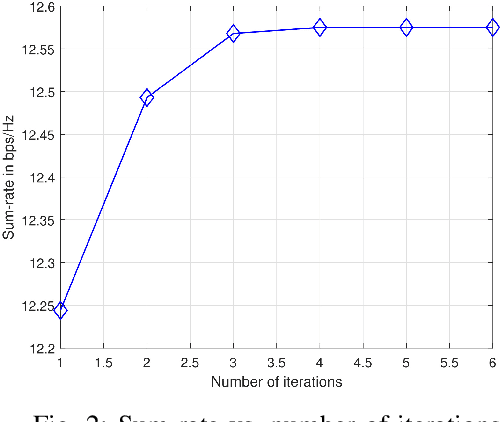
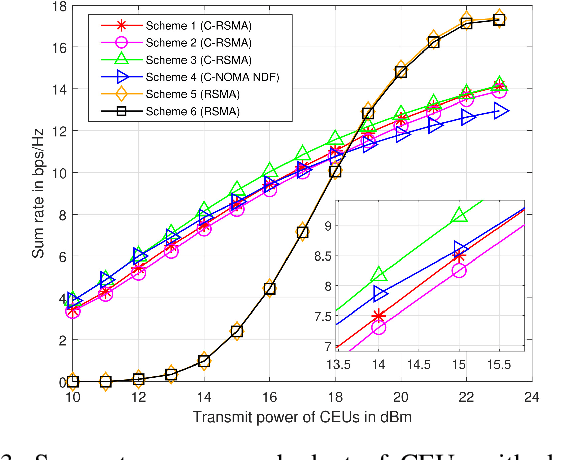
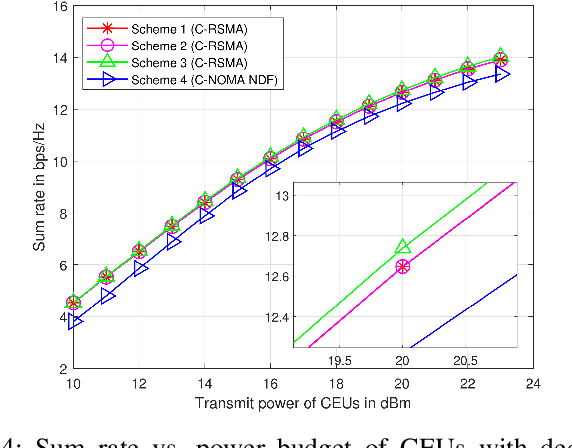
Abstract:This paper investigates joint user pairing, power and time slot duration allocation in the uplink multiple-input single-output (MISO) multi-user cooperative rate-splitting multiple access (C-RSMA) networks in half-duplex (HD) mode. We assume two types of users: cell-center users (CCU) and cell-edge users (CEU); first, we propose a user pairing scheme utilizing a semi-orthogonal user selection (SUS) and a matching-game (MG)-based approach where the SUS algorithm is used to select CCU in each pair which assists in reducing inter-pair interference (IPI). Afterward, the CEU in each pair is selected by considering the highest channel gain between CCU and CEU. After pairing is performed, the communication takes place in two phases: in the first phase, in a given pair, CEUs broadcast their signal, which is received by the base station (BS) and CCUs. In the second phase, in a given pair, the CCU decodes the signal from its paired CEU, superimposes its own signal, and transmits it to the BS. We formulate a joint optimization problem in order to maximize the sum rate subject to the constraints of the power budget of the user equipment (UE) and Quality of Service (QoS) requirements at each UE. Since the formulated optimization problem is non-convex, we adopt a bi-level optimization to make the problem tractable. We decompose the original problem into two sub-problems: the user pairing sub-problem and the resource allocation sub-problem where user pairing sub-problem is independent of resource allocation sub-problem and once pairs are identified, resource allocation sub-problem is solved for a given pair. Resource allocation sub-problem is solved by invoking a successive convex approximation (SCA)-based approach. Simulation results demonstrate that the proposed SUS-MG-based algorithm with SCA outperforms other conventional schemes.
Coordinated Half-Duplex/Full-Duplex Cooperative Rate-Splitting Multiple Access in Multi-Cell Networks
Sep 02, 2024Abstract:This paper explores downlink Cooperative Rate-Splitting Multiple Access (C-RSMA) in a multi-cell wireless network with the assistance of Joint-Transmission Coordinated Multipoint (JT-CoMP). In this network, each cell consists of a base station (BS) equipped with multiple antennas, one or more cell-center users (CCU), and multiple cell-edge users (CEU) located at the edge of the cells. Through JT-CoMP, all the BSs collaborate to simultaneously transmit the data to all the users including the CCUs and CEUs. To enhance the signal quality for the CEUs, CCUs relay the common stream to the CEUs by operating in either half-duplex (HD) or full-duplex (FD) decode-and-forward (DF) relaying mode. In this setup, we aim to jointly optimize the beamforming vectors at the BS, the allocation of common stream rates, the transmit power at relaying users, i.e., CCUs, and the time slot fraction, aiming to maximize the minimum achievable data rate. However, the formulated optimization problem is non-convex and is challenging to solve directly. To address this challenge, we employ change-of-variables, first-order Taylor approximations, and a low-complexity algorithm based on Successive Convex Approximation (SCA). We demonstrate through simulation results the efficacy of the proposed scheme, in terms of average achievable data rate, and we compare its performance to that of four baseline schemes, including HD/FD cooperative non-orthogonal multiple access (C-NOMA), NOMA, and RSMA without user cooperation. The results show that the proposed FD C-RSMA can achieve 25% over FD C-NOMA and the proposed HD C-RSMA can achieve 19% over HD C-NOMA respectively, when the BS transmit power is 20 dBm.
Energy Consumption Optimization in RIS-Assisted Cooperative RSMA Cellular Networks
Aug 13, 2022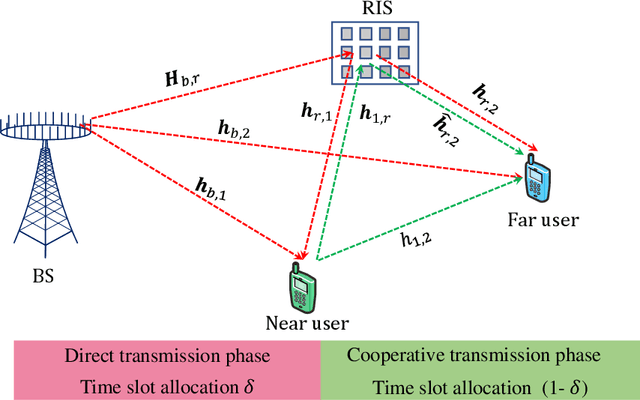
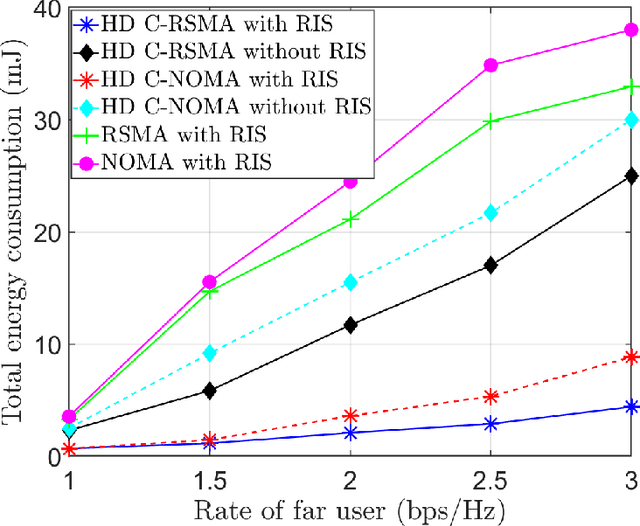
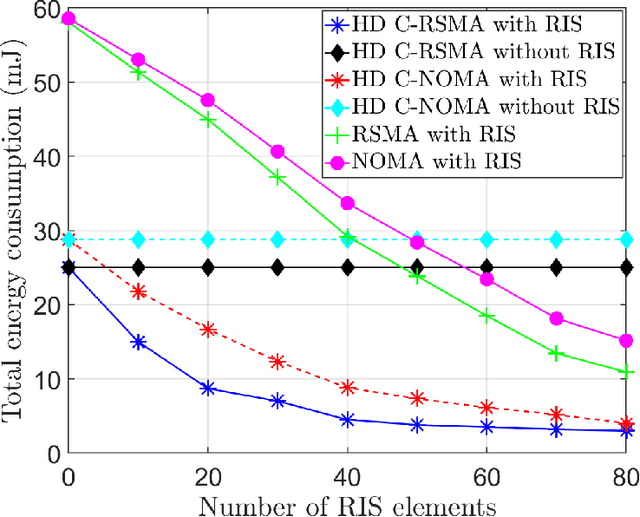
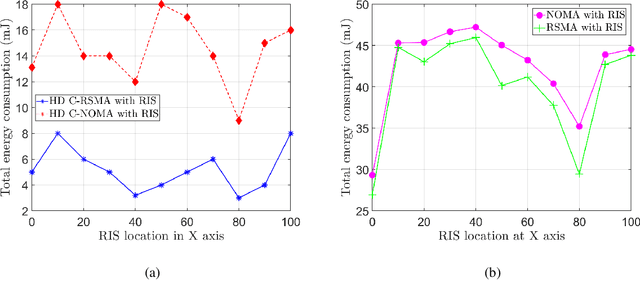
Abstract:This paper presents a downlink reconfigurable intelligent surface (RIS)-assisted half-duplex (HD) cooperative rate splitting multiple access (C-RSMA) networks. The proposed system model is built up considering one base station (BS), one RIS, and two users. With the goal of minimizing the network energy consumption, a joint framework to optimize the precoding vectors at the BS, common stream split, relaying device transmit power, the time slot allocation, and the passive beamforming at the RIS subject to the power budget constraints at both the BS and the relaying node, the quality of service (QoS) constraints at both users, and common stream rate constraint is proposed. The formulated problem is a non-convex optimization problem due to the high coupling among the optimization variables. To tackle this challenge, an efficient algorithm is presented by invoking the alternating optimization technique, which decomposes the original problem into two sub-problems; namely, sub-problem-1 and sub-problem-2, which are alternatively solved. Specifically, sub-problem-1 is to jointly optimize the precoding vectors, common stream split, and relaying device power. Meanwhile, sub-problem-2 is to optimize the phase shift matrix at the RIS. In order to solve sub-problem-1, an efficient low-complexity solution based on the successive convex approximation (SCA) is proposed. Meanwhile, and with the aid of difference-of-convex rank-one representation and the SCA approach, an efficient solution for the phase shift matrix at the RIS is obtained. The simulation results demonstrate that the proposed RIS-assisted HD C-RSMA achieves a significant gain in minimizing the total energy consumption compared to the RIS-assisted RSMA scheme, RIS-assisted HD cooperative non-orthogonal multiple access (C-NOMA), RIS-assisted NOMA, HD C-RSMA without RIS, and HD C-NOMA without RIS.
 Add to Chrome
Add to Chrome Add to Firefox
Add to Firefox Add to Edge
Add to Edge